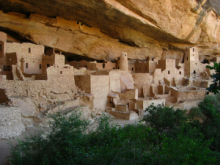Article
The Anasazi, or Ancestral Puebloan peoples, of the southwestern regions of the United States often built their houses on the sides of canyon cliffs using natural rock overhangs and large caves as the base for their structures. Many standing ruins of cliff dwellings that were built in the period around 1150-1300 CE can be found in the Four Corners area in present day Colorado, Utah, Arizona, and New Mexico. The early, nomadic Puebloan peoples started building these structures by enclosing existing cliff caves with stone building blocks and adobe mortar to create storage bins for gathered and hunted foods. Later on, a similar technique was used to build larger rooms that were used as living structures. The settlements were often built on high canyon walls as a way to protect the community from predators and hostile neighboring tribes. Steps were carved into rocks, and wooden ladders were used to climb up and down the canyon walls. Some of the most impressive cliff dwelling ruins are located in Mesa Verde National Park in Colorado, the Gila National Monument in New Mexico, and Walnut Canyon in Arizona.
"Cliff Palace, Mesa Verde National Park, July 30, 2010" by Ken Lund is licensed under CC BY-SA.
Manuscripts
A01 The Blessing Way (01-07) p. 35
A01 The Blessing Way (01-07) p. 82
A01 The Blessing Way (01-07) p. 167
A01 The Blessing Way (01-07) p. 169
A01 The Blessing Way (01-07) p. 176
A01 The Blessing Way (01-07) p. 188
A01 The Blessing Way (01-07) p. 189
A01 The Blessing Way (01-07) p. 206
A01 The Blessing Way (01-07) p. 210
A01 The Blessing Way (01-07) p. 228
References
Encyclopedia Britannica Online
N.d. cliff dwelling. http://www.britannica.com/technology/cliff-dwelling, accessed August
24, 2015.

